How to Rank Higher (& Get More Visibility) on Google


Written by Leigh McKenzie & Chris Hanna

If you want to rank higher on Google this year, you’re in the right place.
In this guide, I’ll show you the exact strategy we’re using right now to maximize visibility for keywords like “SEO best practices”:
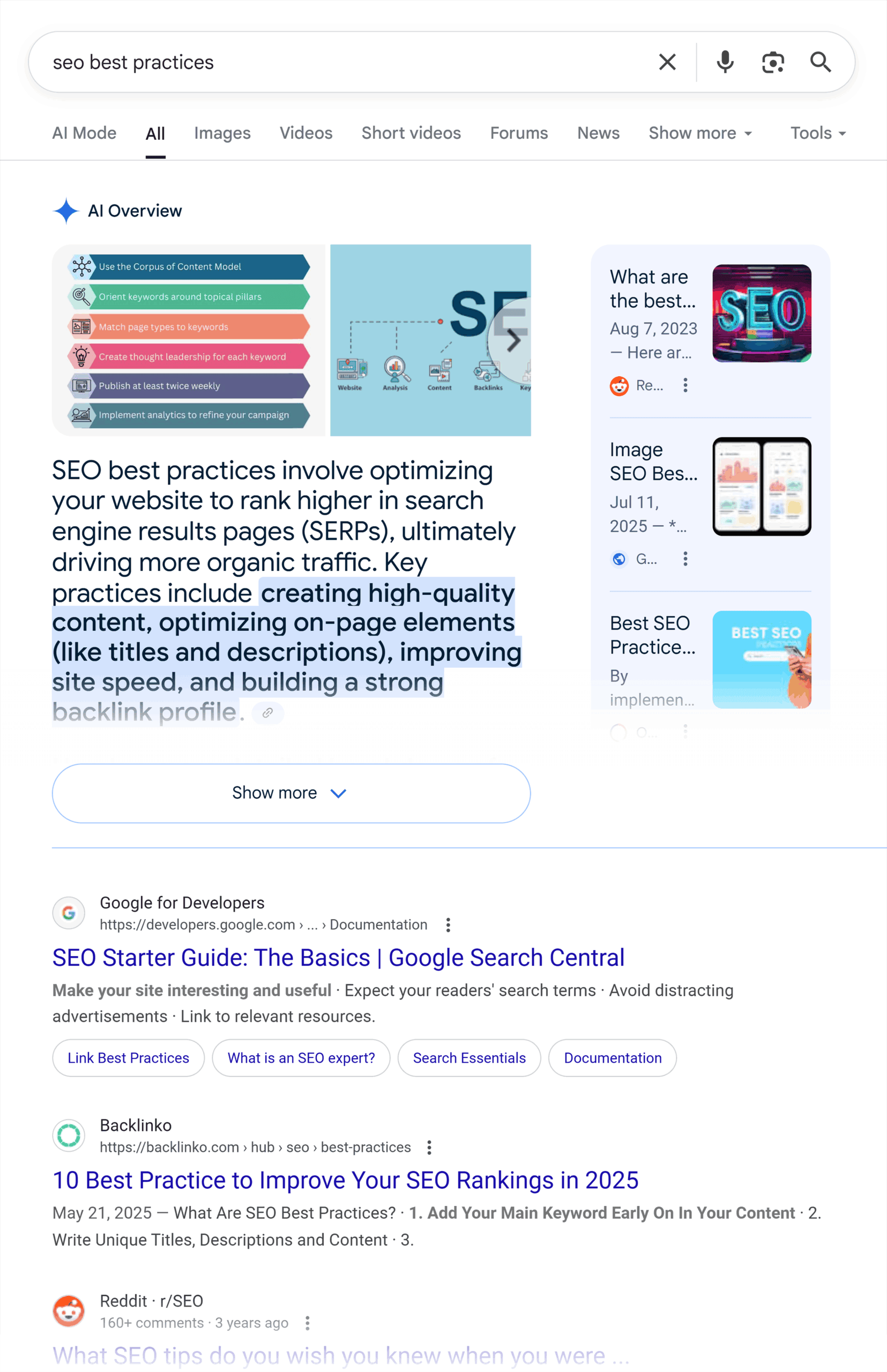
And “keyword rankings”:

It’s also helping us influence LLMs, like ChatGPT:
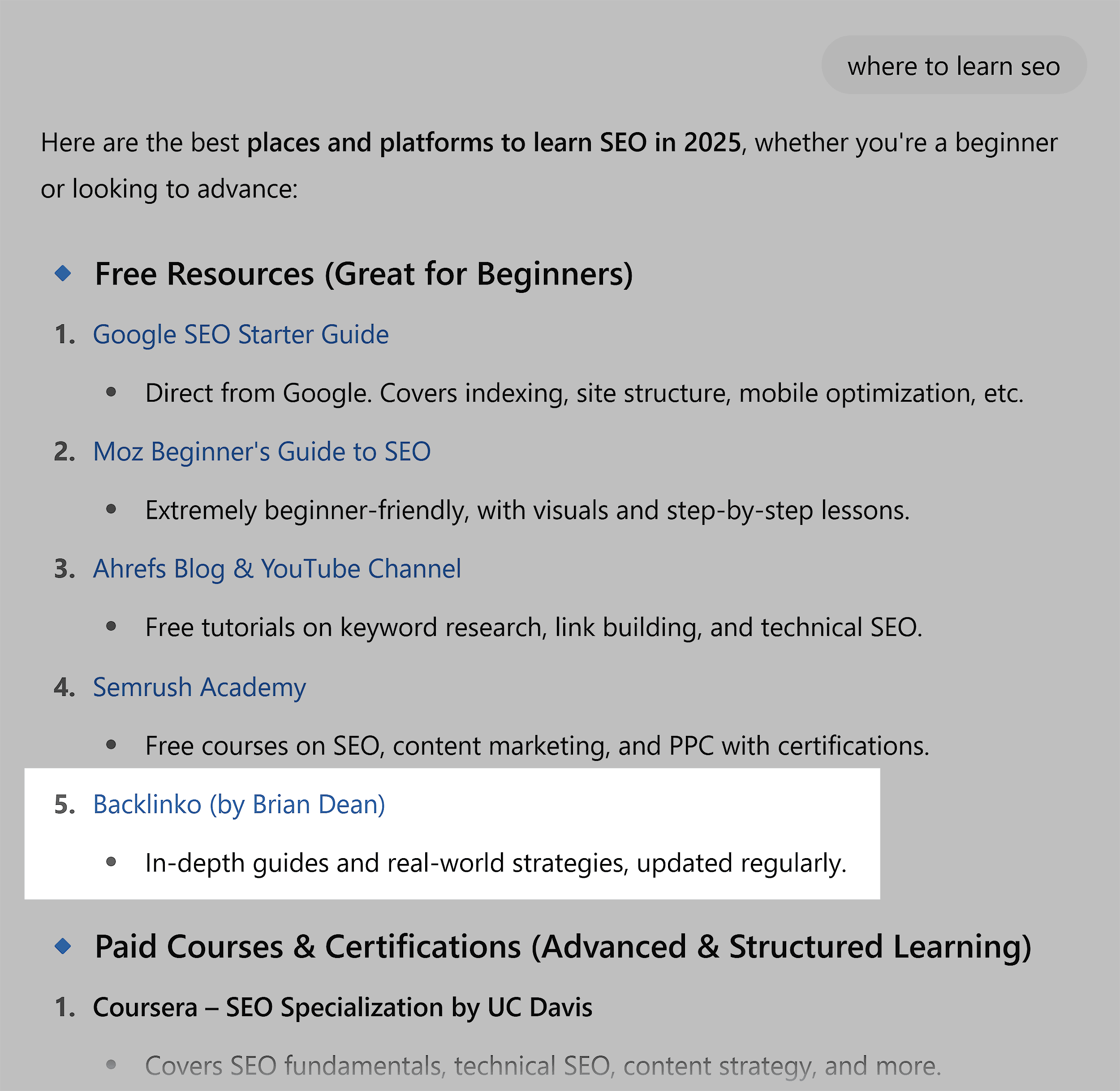
And Google’s Gemini:

These aren’t just top rankings. They’re high-visibility placements across multiple surfaces — AI Overviews (AIOs), organic results, and LLM chatbots.
That’s the reality of SEO in 2025.
If you only focus on where you rank in one search engine, you’re missing the bigger picture.
What matters now is how your content is being presented and where it’s being pulled into the experience.
Google and other AI platforms now:
- Pull passages, not just pages
- Surface answers before links
- Highlight brands that are consistently mentioned, even without backlinks
In the guide below, I’ll show you the tactics and tools we’re using to make sure our content gets discovered across the entire AI-powered web.
But first, a primer on what it actually means to rank higher on Google these days.
How Does Google (and AI) Rank Pages Today?
Search engines don’t just rank pages anymore. They assemble answers.
When someone performs a search:
- Google analyzes the intent behind the query
- It then pulls relevant passages from across the web
- And it compiles the most useful pieces into features like AI Overviews, snippets, and carousels
Yes, there are still (usually) 10 blue links. But SERP features are a huge component of the results pages.
Here’s a deeper dive on what’s going on.
Intent Matching at the Passage Level
Google breaks your content into chunks and matches them to specific search intents. You’re not ranking as one page — you’re competing passage by passage.
Take this example, “what is an seo campaign”:
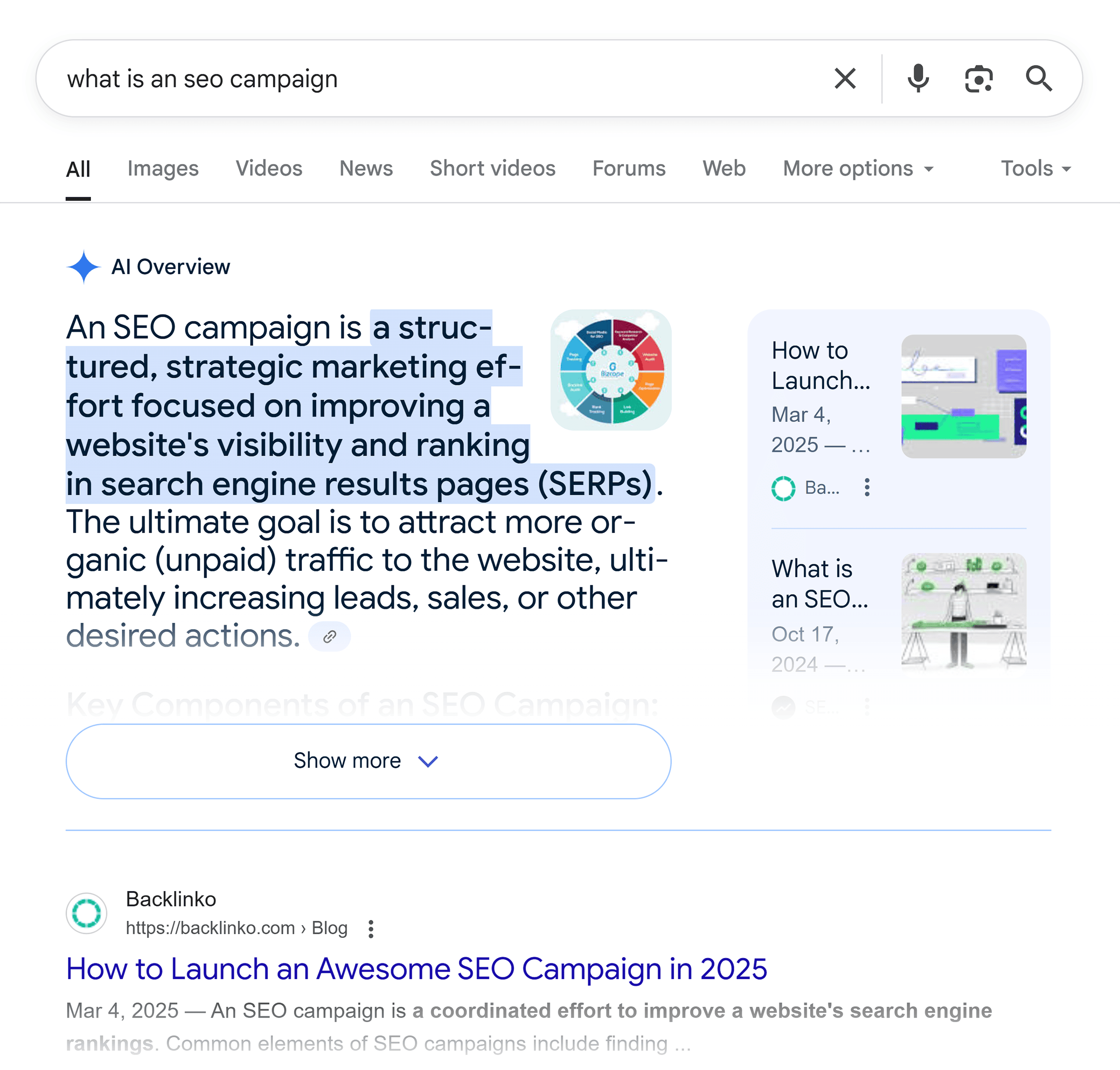
Google matches, and links directly to, the relevant paragraph in the article:
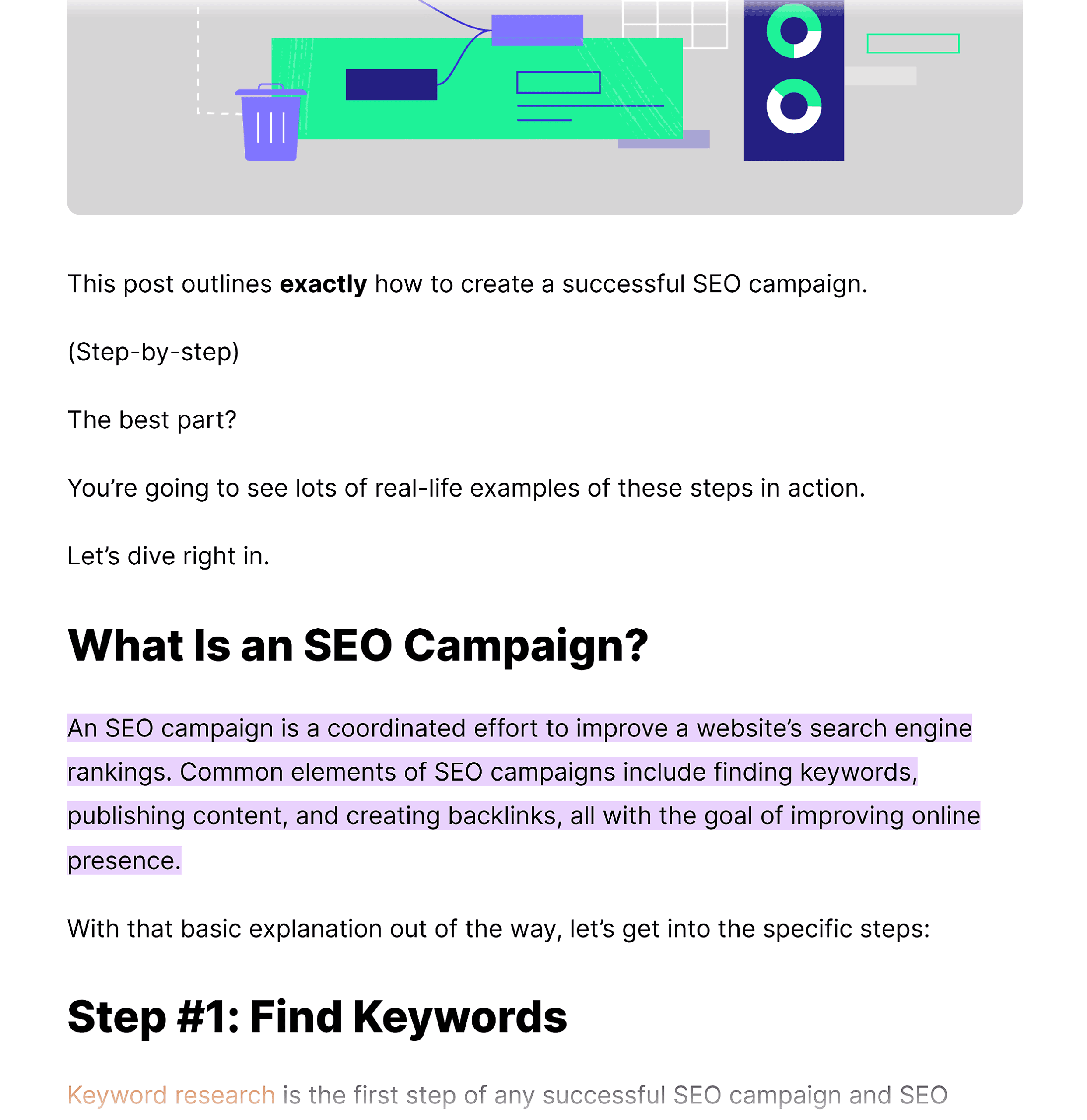
(More on how to optimize for that in Step 2 below.)
This isn’t just true for the AI Overviews though — it’s long been the case for ranking in the featured snippet at the top of Google’s traditional search results:
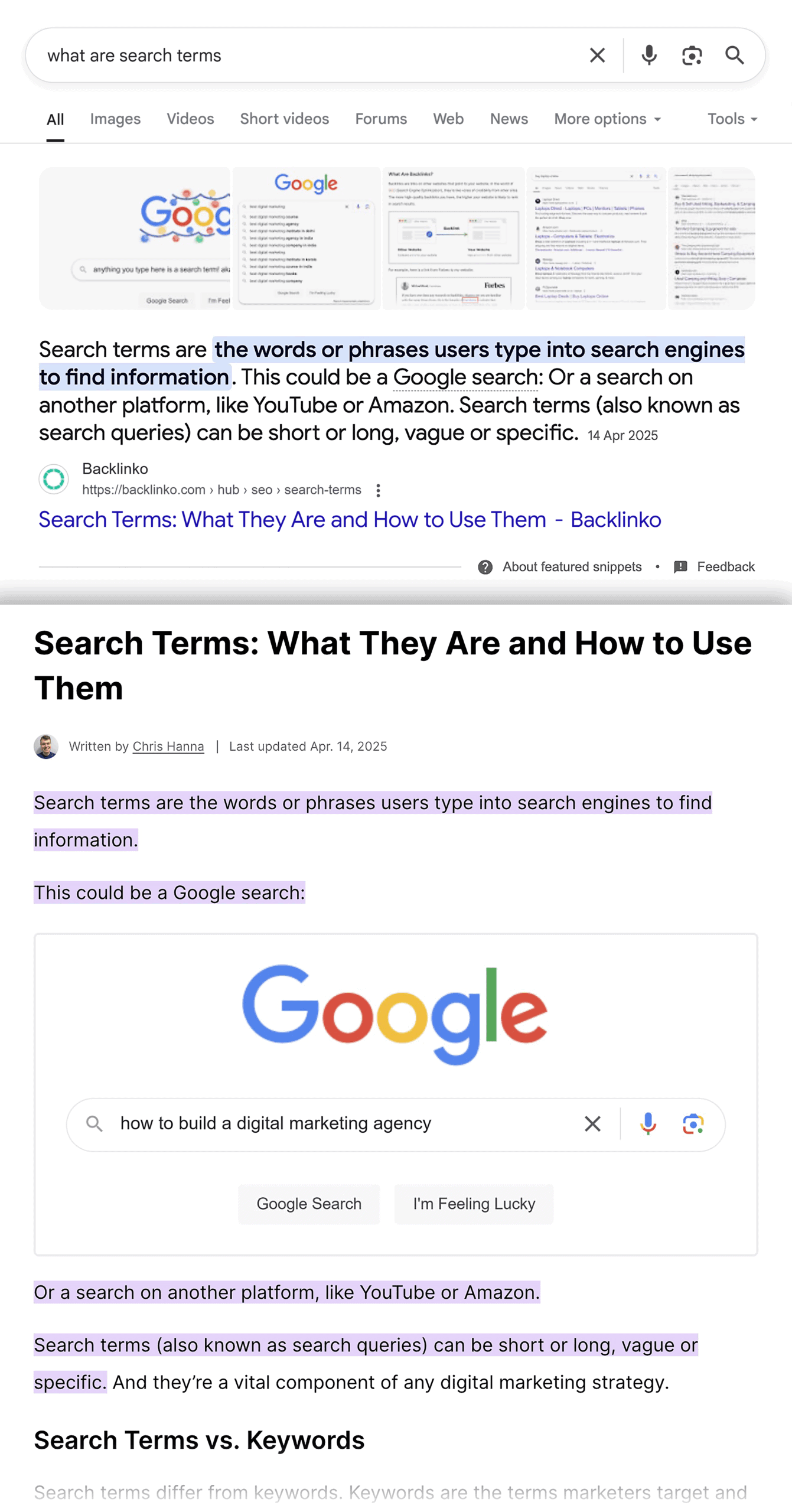
LLM-Driven Summarization
AI Overviews and chat tools like Gemini or ChatGPT pull data from content that’s structured clearly and appears trustworthy, regardless of its ranking position.
That’s why you’ll often see sources linked in the AI Overviews that aren’t even on page 1. Like this example, where the CDC is quoted 3+ times in the AIO, but doesn’t appear anywhere on the first page:
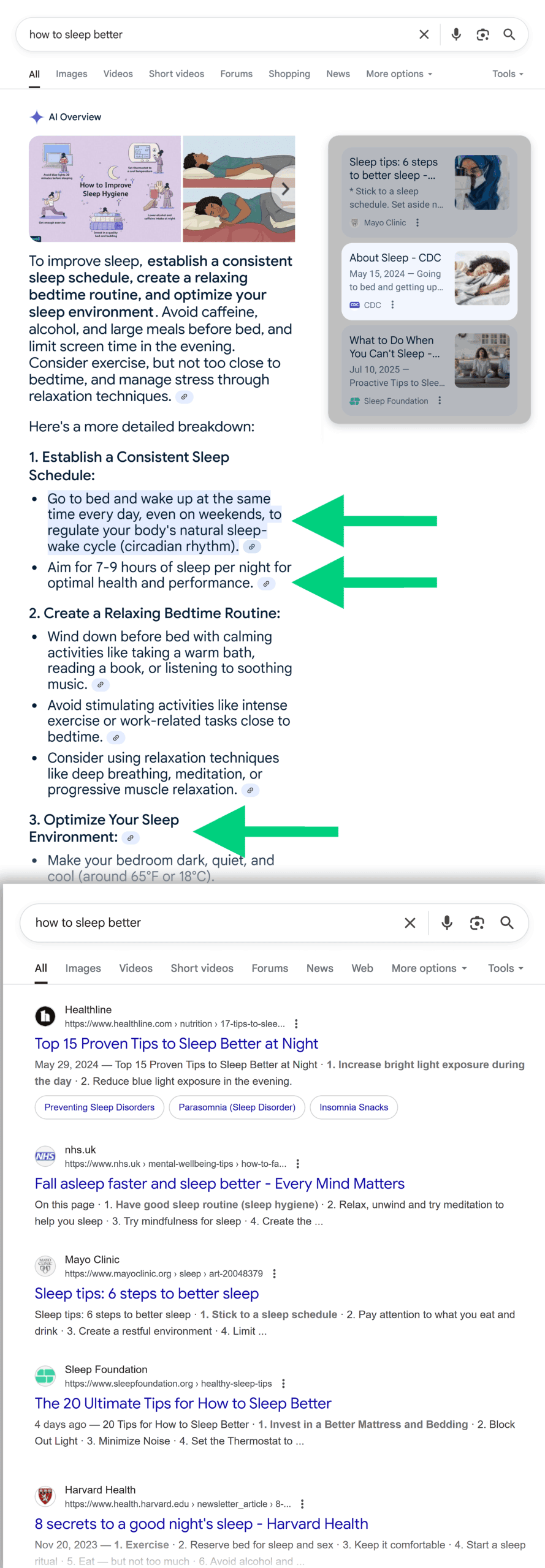
Unlinked Mentions and Brand Presence
Repeated brand mentions (even without backlinks) influence which sources LLMs cite or summarize. Authority isn’t just about links anymore — it’s about presence.
AI Overviews are already leaning on forums, for example:
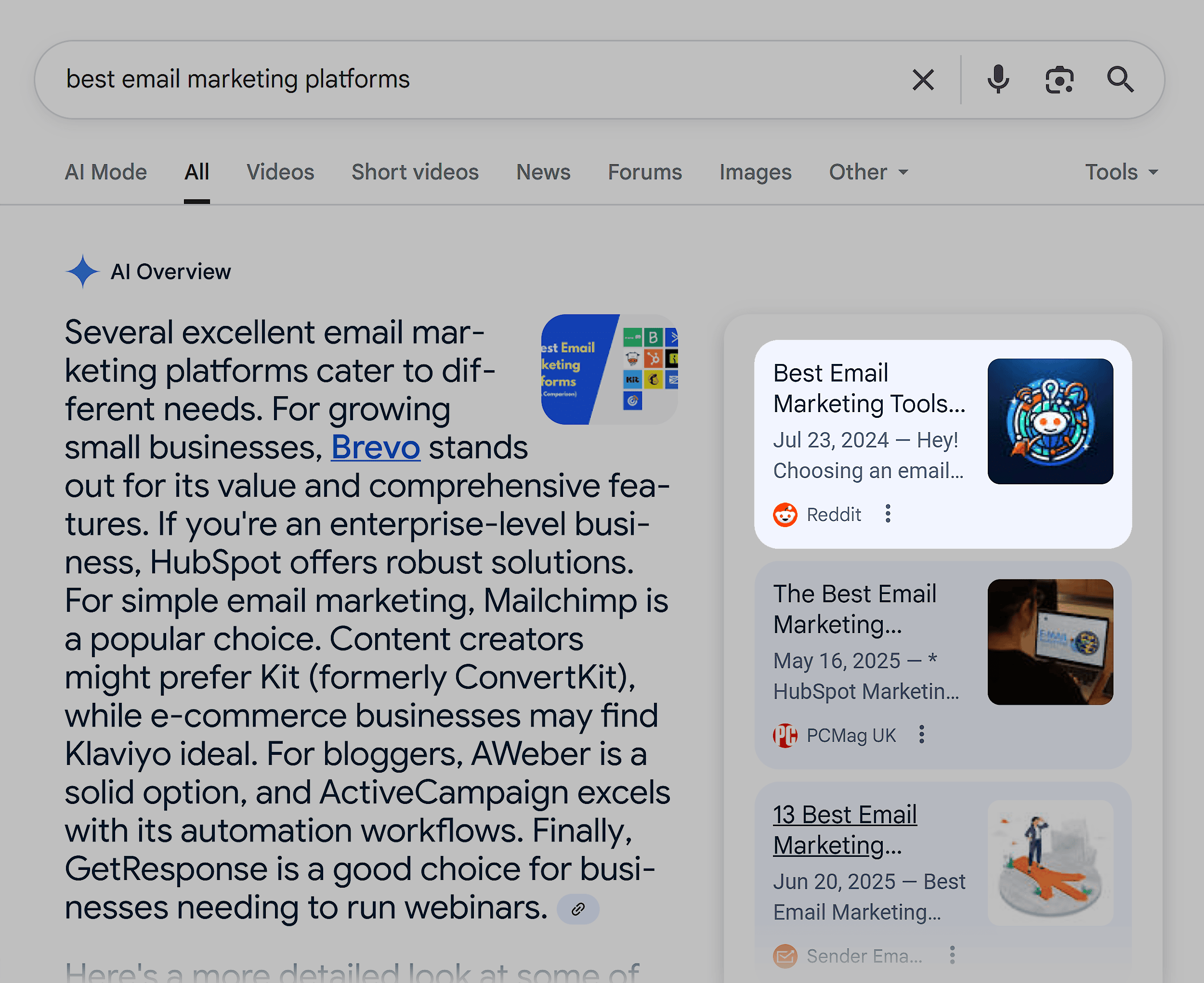
These are unlinked mentions, often deep within discussions. Yet they’re helping direct what appears at the very top of the Google search results.
Content Satisfaction Signals
Dwell time, engagement, and whether users continue their search (or stop) all send signals to Google and Gemini (which powers the AIOs) about which content actually solves the query.
So if your content:
- Doesn’t give your user value immediately
- Is packed with dense paragraphs
- Lacks clear structure
- Feels generic
You’re probably going to be ignored. Even if you do rank.
To win visibility today, your content needs to:
- Answer specific intents clearly and quickly
- Be structured so Google (and other AI tools) can easily parse it and pull it apart to match relevant sections to specific queries
- Reinforce your brand’s credibility and topical depth
(And still be optimized for all the SEO basics, of course.)
That’s the bar in 2025. And everything in this guide is built to help you hit it.
Tip #1: Nail the Basics of Traditional SEO
Even though Google Search is changing, the fundamentals still matter.
The absolute basics of SEO still move the needle when you layer them on top of quality content and everything else we’ll discuss below.
Useful resource: If you’re still pretty new to search engine optimization, check out our beginner’s SEO guide.
For now, here’s what to focus on to rank higher, faster.
Optimize for Your Target Keywords
Targeting words people use when searching is still a fundamental aspect of SEO.
Free tool: If you’re still looking for the right terms to target, try our free keyword research tool.
Include your target keyword and variations of it throughout your content (naturally).
Also include it in your headings and (perhaps most importantly) in your title tag.
Your title tag is still one of the strongest ranking signals Google looks at.
So, make it compelling, but also include your target keyword. Like we did here for our article on SEO strategy:

Speed Up Your Pages
Page speed is a ranking factor. So if you improve your page speed, you can rank higher on Google.
You can check your page speed and find out where you can make improvements by running your site through the free PageSpeed Insights tool:
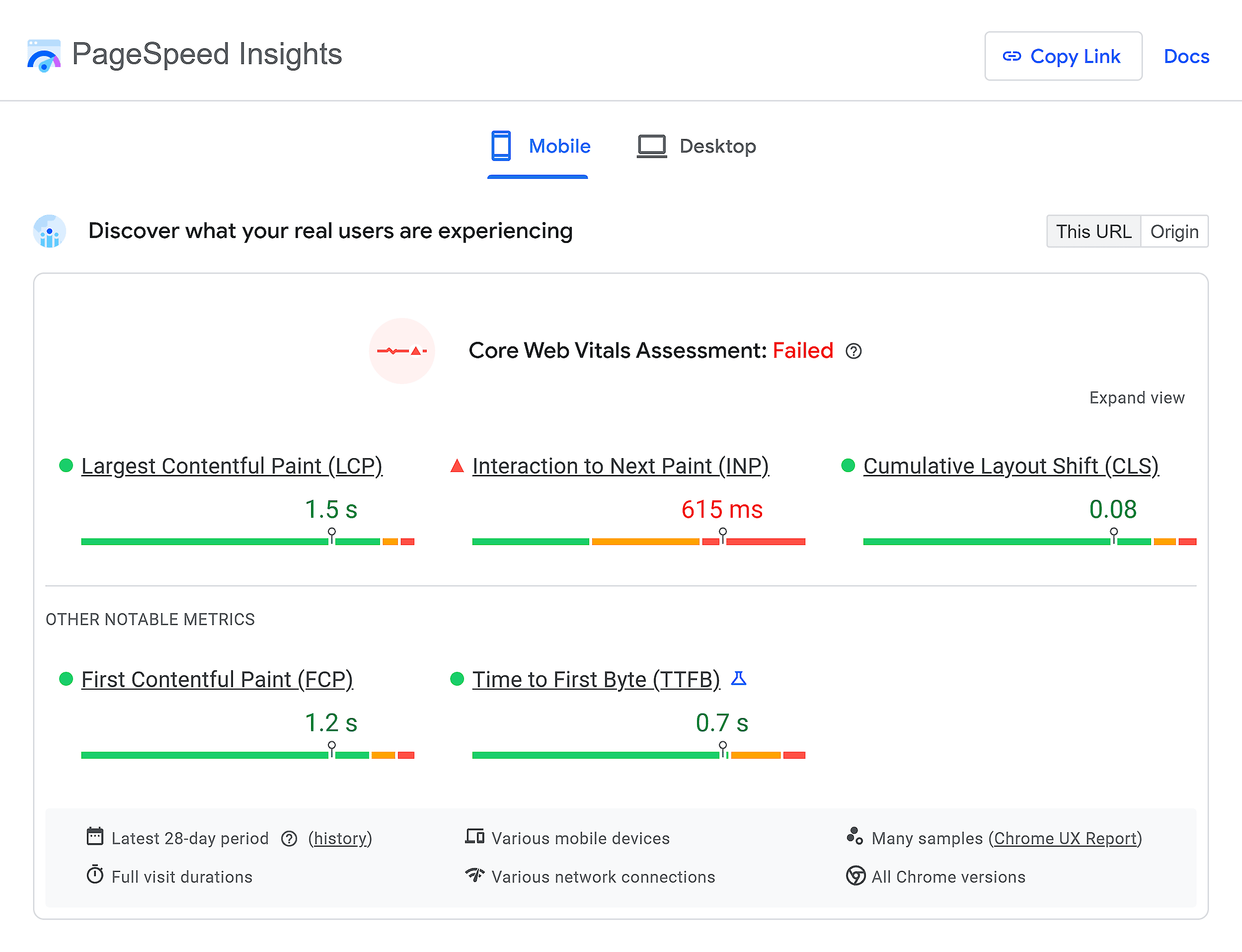
Optimize for Mobile
When your pages load slowly or look broken on mobile, users bounce back to search results. That sends negative satisfaction signals to Google about your content.
Fast, mobile-friendly pages provide better user experience.
This ties directly into the satisfaction signals and business metrics that matter most (more on these later). But it also just makes users more likely to trust you and eventually convert.
Use Strategic Internal Linking
Good internal links help both users and search engines navigate your content.
How do you implement them properly?
Use descriptive anchor text and link to relevant, helpful pages. Don’t overthink it.

For more specific guidance, check out our post about internal linking (see what I did there?).
Other basics to nail down include:
- A logical site structure
- Crawlable and indexable pages
- Building a natural backlink profile
These fundamentals create the foundation that lets all your other SEO efforts actually work.
Get the basics right first, then layer on the advanced strategies.
Tip #2: Optimize for Content Satisfaction Signals
Google doesn’t just look at who clicks. It looks at who clicks back.
If someone lands on your page, doesn’t find what they need, and returns to the search results to try again? That tells Google your content wasn’t satisfying.
This isn’t about bounce rate or time on page in your analytics tool.
It’s about bounce-back to the SERP. A real-world signal that your content didn’t deliver.
Here’s how you make sure you do deliver:
Lead with the Answer
Don’t bury the good stuff. Put your main point, solution, or key information right at the top of your content.
We do this all the time. For example, check out this post on E-E-A-T:
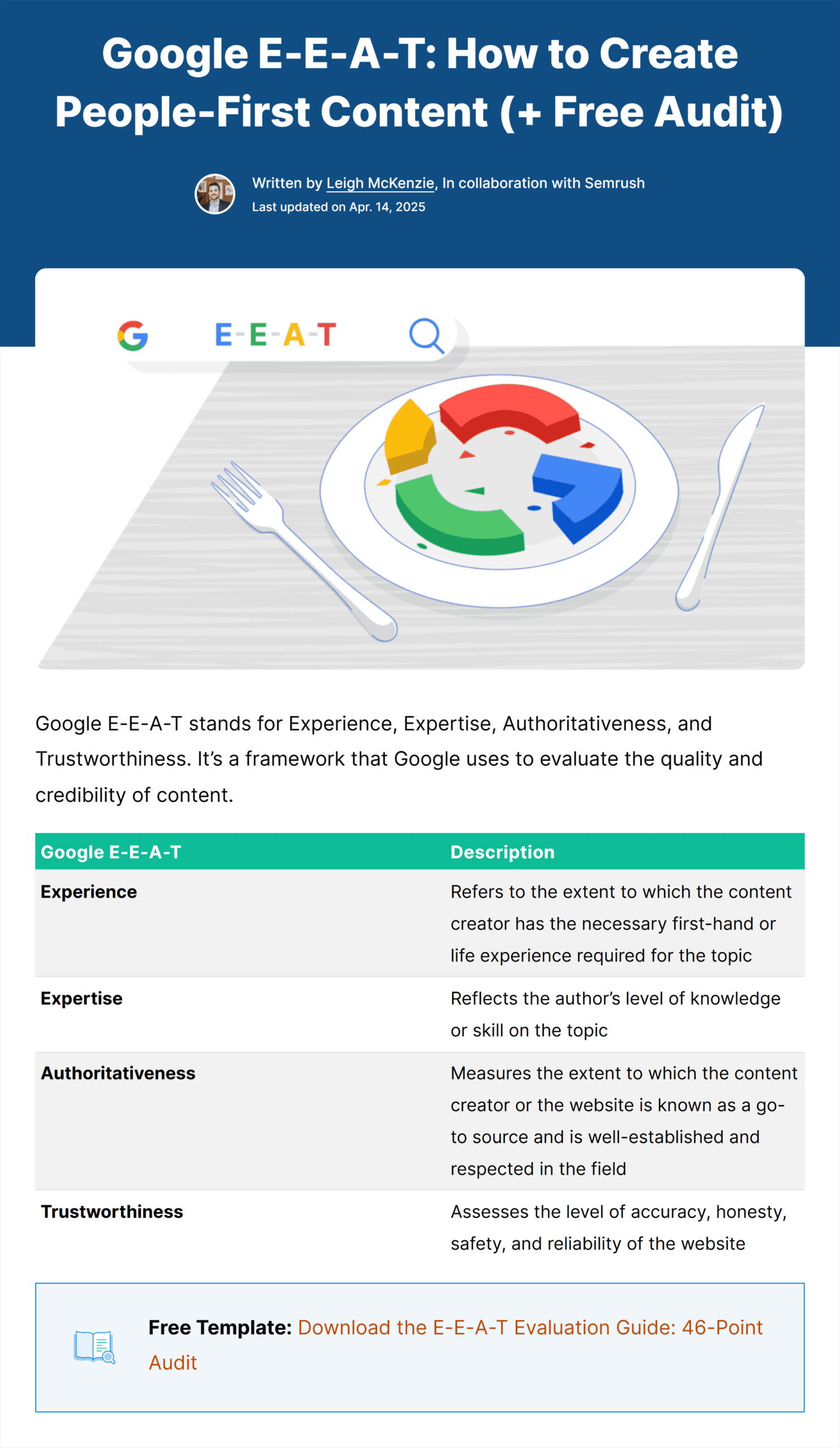
Within the first section, we give the reader a:
- Straight answer to the question of what E-E-A-T stands for
- Table explaining what each of the components actually means in practice
- Free template to audit their own site’s E-E-A-T
This approach works for more than just user experience. When you lead with clear, direct answers, you’re more likely to get pulled into AI Overviews and featured snippets.
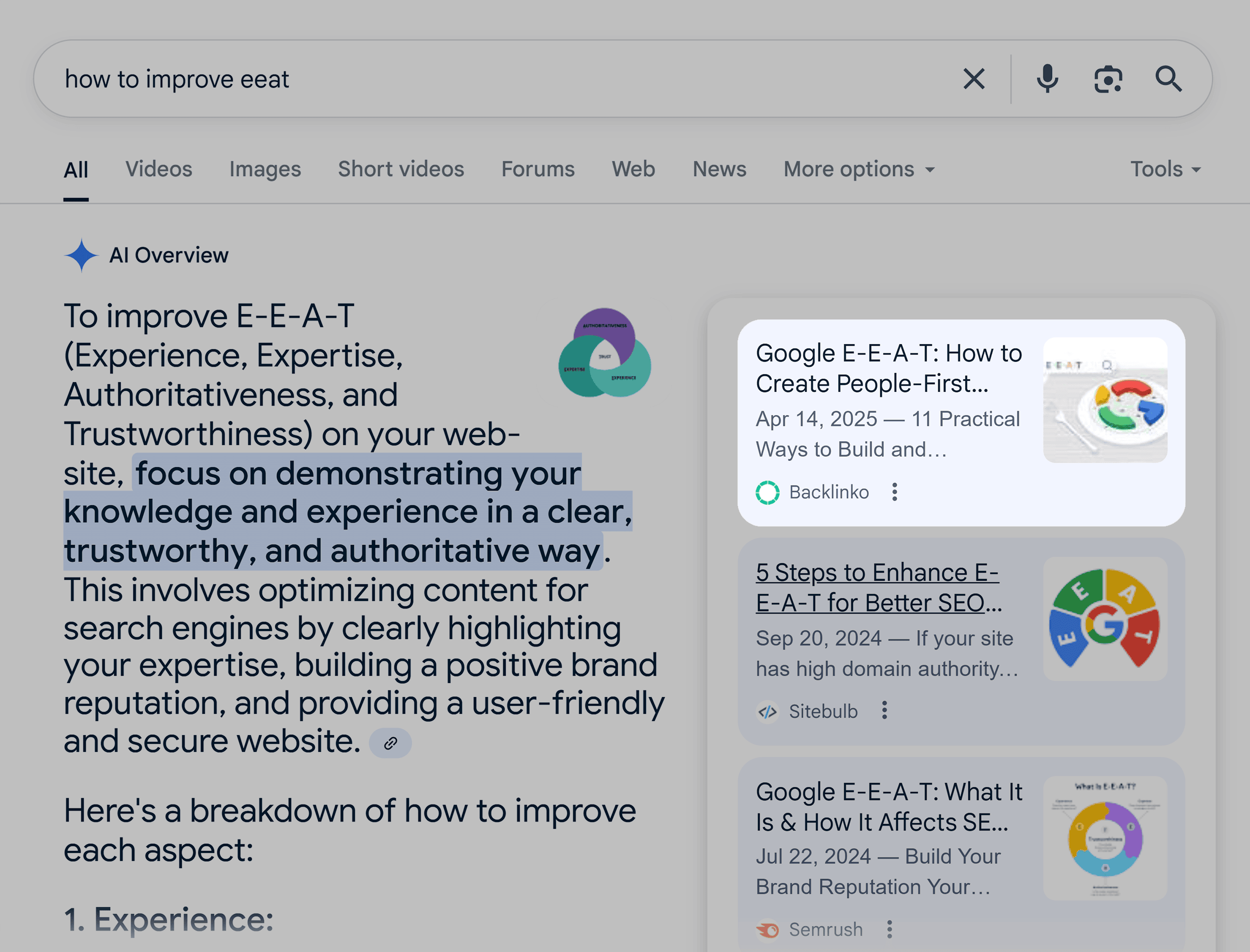
Write in Short Bursts
To keep readers engaged, use short sentences and paragraphs. Like we do here at Backlinko:
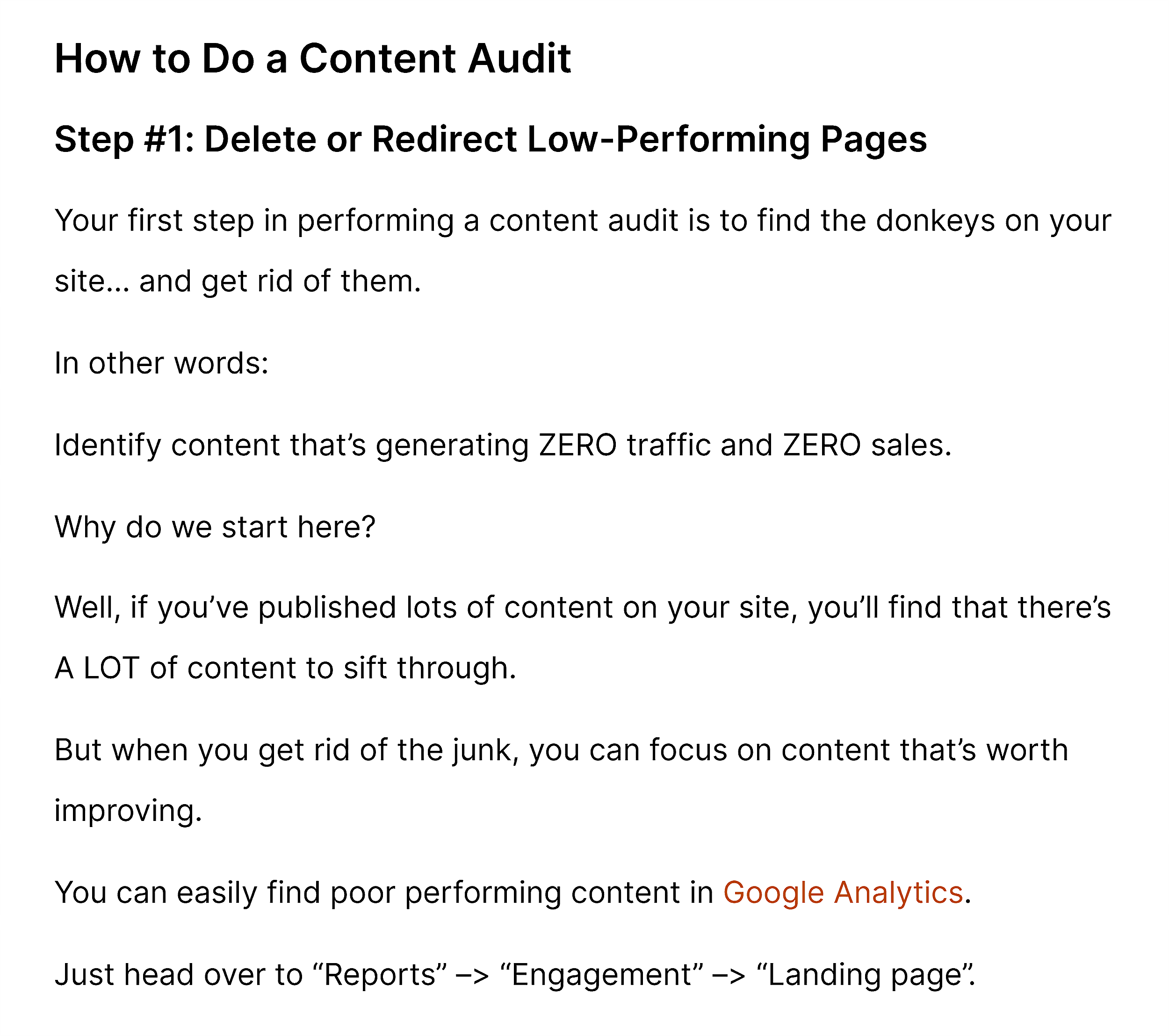
This makes your content easier to scan and digest. In other words: you make it quicker and easier for the reader to get what they need.
Notice how this very guide is structured?
Each point gets its own space to breathe. You’re not fighting through walls of text to find what you need.
This encourages readers to spend more time on the page, potentially sending useful signals to Google about our content quality.
Use Clear Formatting That’s Effortless to Skim
When your content is well-organized with clear subheadings, users can quickly find their answers.
This is yet another technique that we use:

Search engines and AI tools can also parse and understand your content layout more easily when you chunk your content like this.
This makes it more likely that you’ll appear in AI Overviews and other generative results.
Break Up Your Content with Visuals and Examples
Visuals help make your content easier to digest while also giving readers a more valuable experience.
But only if they actually add real value, not just decoration.
Skip the generic stock photos and text-heavy images. Instead, use:
- Screenshots that show exactly what you’re explaining
- Charts or graphs that illustrate your points
- Step-by-step visual guides
- Before/after comparisons

Tip #3: Write Clear, Well-Structured Content
This one is simple, but so underused.
The best websites have always done this. But now it matters even more since AI search tools often surface individual sections of content — not entire pages.
Search engines and LLMs don’t care how long your post is or if you mention your target keyword a certain number of times (although keyword optimization is still important). They care how clearly it answers real questions.
Here’s how to make sure your content does that.
Use Logical Headings and Match Them to Your Content
Your headings help guide users and search engines through your content.
There’s no need to over-optimize or overthink this: just think of your headings as signposts that point your users and search engines (and AI tools) to each part of your content.
If your content doesn’t match the heading above it, you’ll likely confuse both users and bots. So avoid using generic headings that don’t explain what’s coming below it.
Bad example:
Here’s Why This Matters
Good example:
Why SEO Matters for Small Businesses
Add a Table of Contents and/or Jump Links
Let users skip straight to what they came for.
This works especially well for comprehensive guides or tool roundups. You might structure it with H2s for categories and H3s for individual tools or steps.
We do this with a dedicated table of contents on our posts:
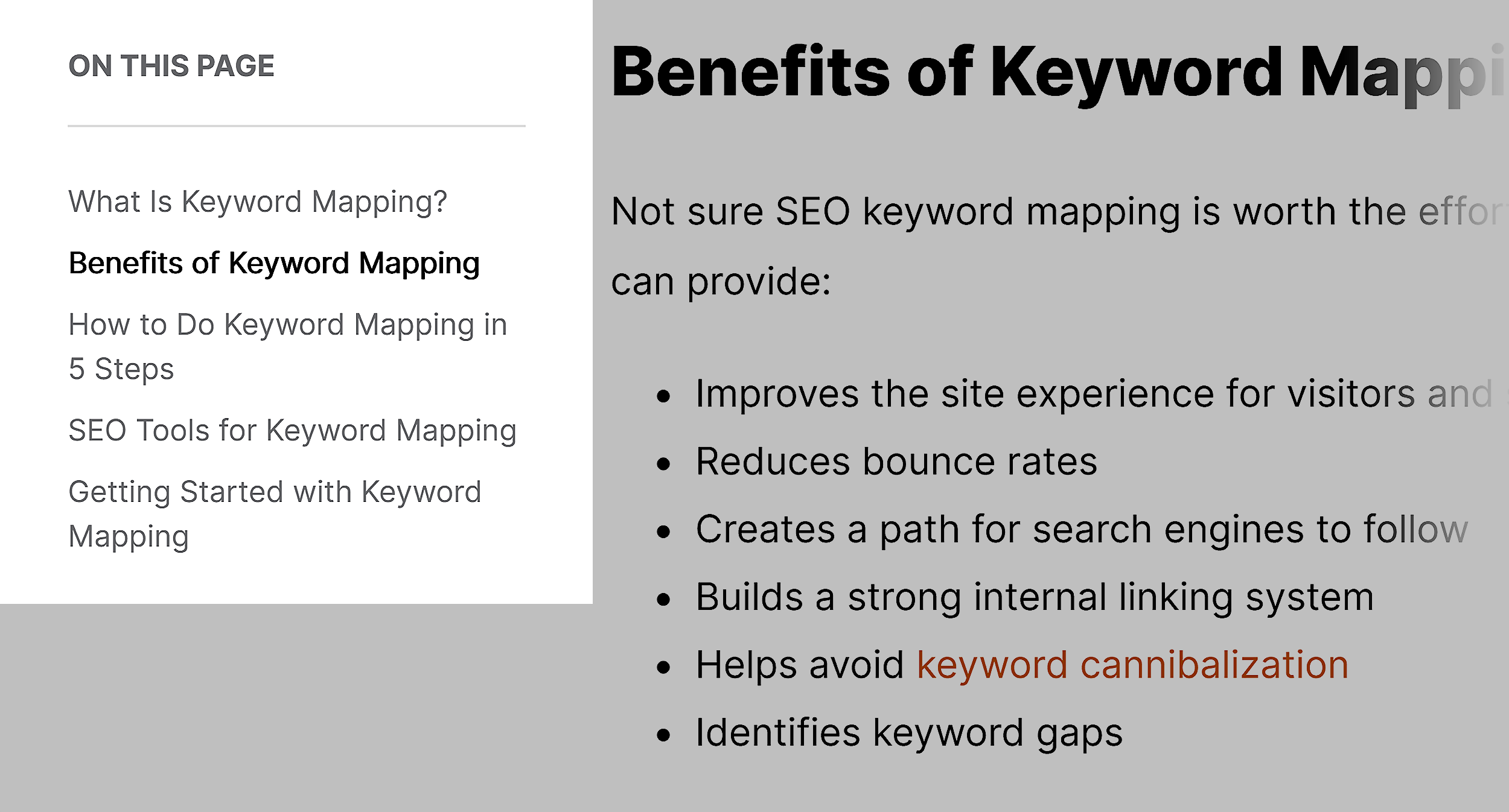
But we also add jump links in the content where it makes sense:
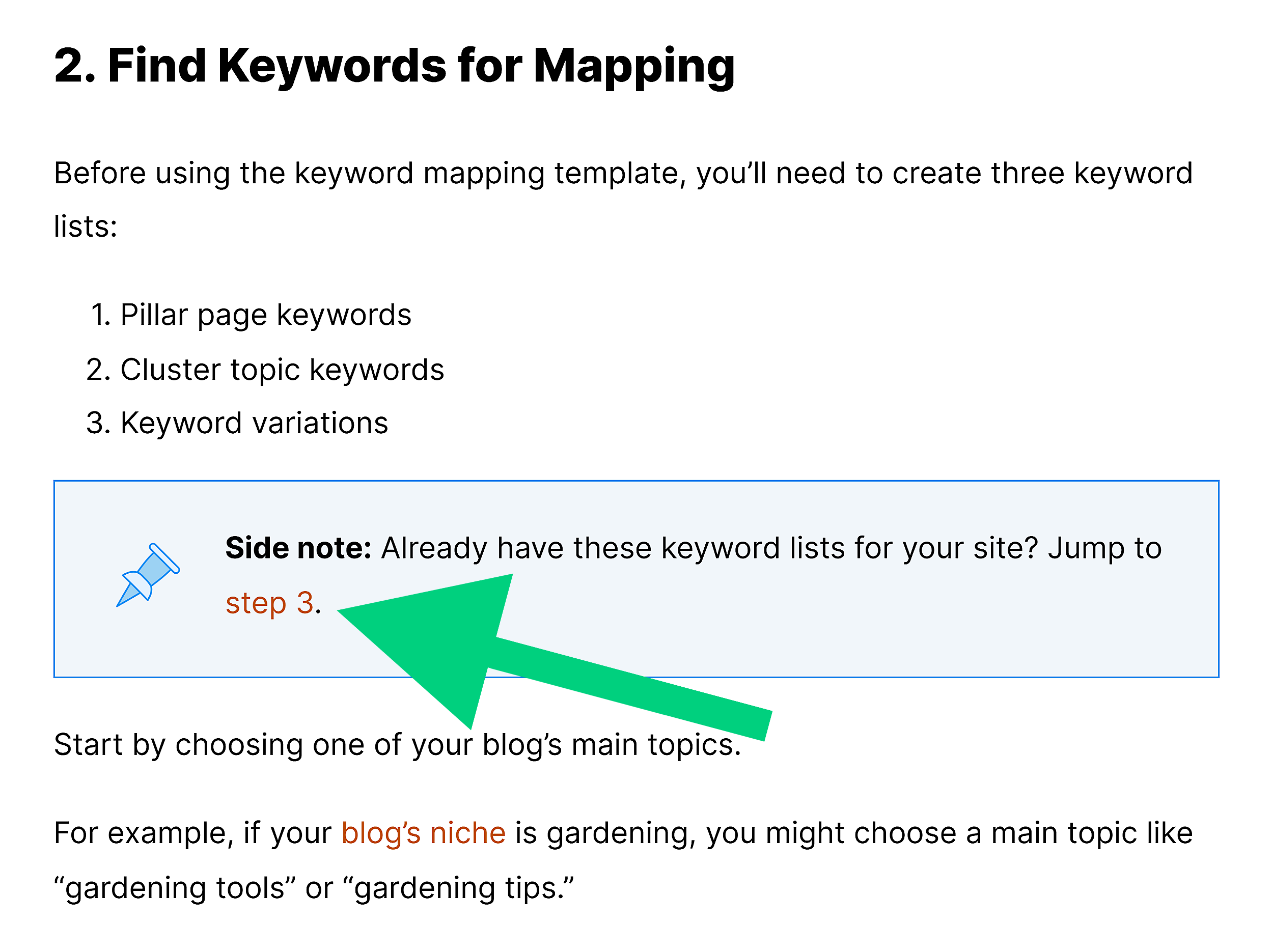
This way, users can jump to exactly what they need instead of scrolling through everything.
Follow the Inverted Pyramid Structure
With the inverted pyramid structure, you start each section with the most important points. You then continue into the supporting information, context, or statements, and you finish with the less important but still useful content.
Like this example:
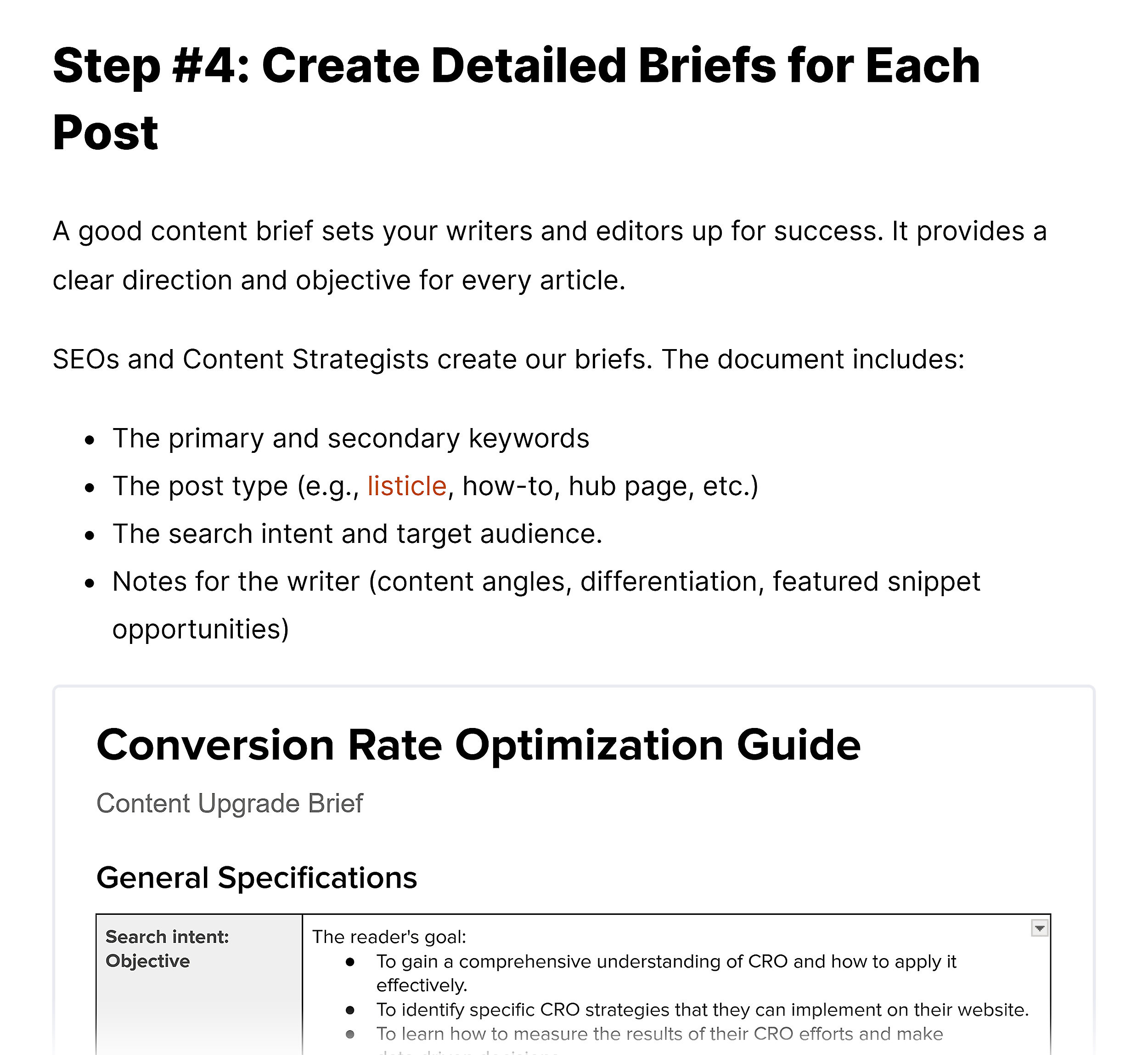
The heading sets up what the section will cover (creating detailed briefs for posts). The first sentence is the most important point (why a brief matters).
Then, there’s some supporting information with examples and an image (what the document includes, along with a screenshot).
Finally, the end of the section includes some “nice to have” information. It’s not critical, but it gives the reader some more relevant tips:

Tip #4: Go Deep on Your Topic (Not Wide)
Topical authority beats generalist fluff.
But nowadays, topical authority isn’t just about covering everything under a topic and calling it a day. You can’t expect to pick up rankings for keywords across the board just by publishing more content.
Real topical authority means merging first-hand experience and expertise with great writing, clear structure, and a deep understanding of user intent.
You give users everything they need to know within a piece of content — without creating a 10,000-word article when a 2,000-word article will do the job better.
So, publish content that reinforces your core topic.
Here at Backlinko, we focus on SEO, content marketing, and digital marketing strategies. We don’t suddenly start writing about web development or running a business just because those topics have a high search demand.

This instantly makes it easy for everyone on our team to go deep, not wide.
With a laser focus on the search intent for each topic we take on, nobody feels like they need to cover absolutely everything under the sun. And our readers don’t feel overwhelmed with lots of unnecessary information.
Instead, we just ensure we create content that answers all their important questions about a topic.
Tip #5: Build Topic Clusters with Smart Internal Linking
Topic clusters are groups of pages covering a single topic or theme in detail.
You typically have a pillar page that goes deep on the broad overall topic. Then you have cluster pages that discuss more specific aspects or concepts under that broad topic.
For example, we have a topic cluster all about YouTube marketing:

Clusters can help you cover topics in depth and in a way that’s highly optimized for your target keywords.
Need proof?
Our YouTube marketing topic cluster drives 12K clicks every month:

Once you’ve created your topic clusters, the next step is to link all the pages together.
When you mention a concept you’ve covered in detail elsewhere, link to that content using descriptive anchor text that tells both users and search engines what they’ll find.
Prioritize links to and from high-converting or high-authority pages. Again, this ties back to focusing on business outcomes rather than just the highest-volume keywords.
If you have data showing which pages convert best, make sure those get priority in your linking strategy.
Use a hub and spoke structure for your topic clusters. Create pillar pages for your main topics, then build subtopic content that links back to those pillars.

For more info on linking all your pages together in this way, check out our full guide to creating topic clusters.
Tip #6: Use Related Entities and Subtopics
Entities are the people, places, things, and concepts that search engines recognize and understand. Think of them as the building blocks that help search and AI systems make sense of your content.
Targeting entities and the relationships between them isn’t groundbreaking to SEO. These concepts have always mattered.
But everyone needs to think about them more intentionally now.
You can have a play around with Google’s own tool to help understand how this works. It uses NLP (natural language processing).
You don’t need to know what that is to rank higher on Google. But getting a basic understanding of what entities are is a good idea, and the tool does a good job of visualizing it.
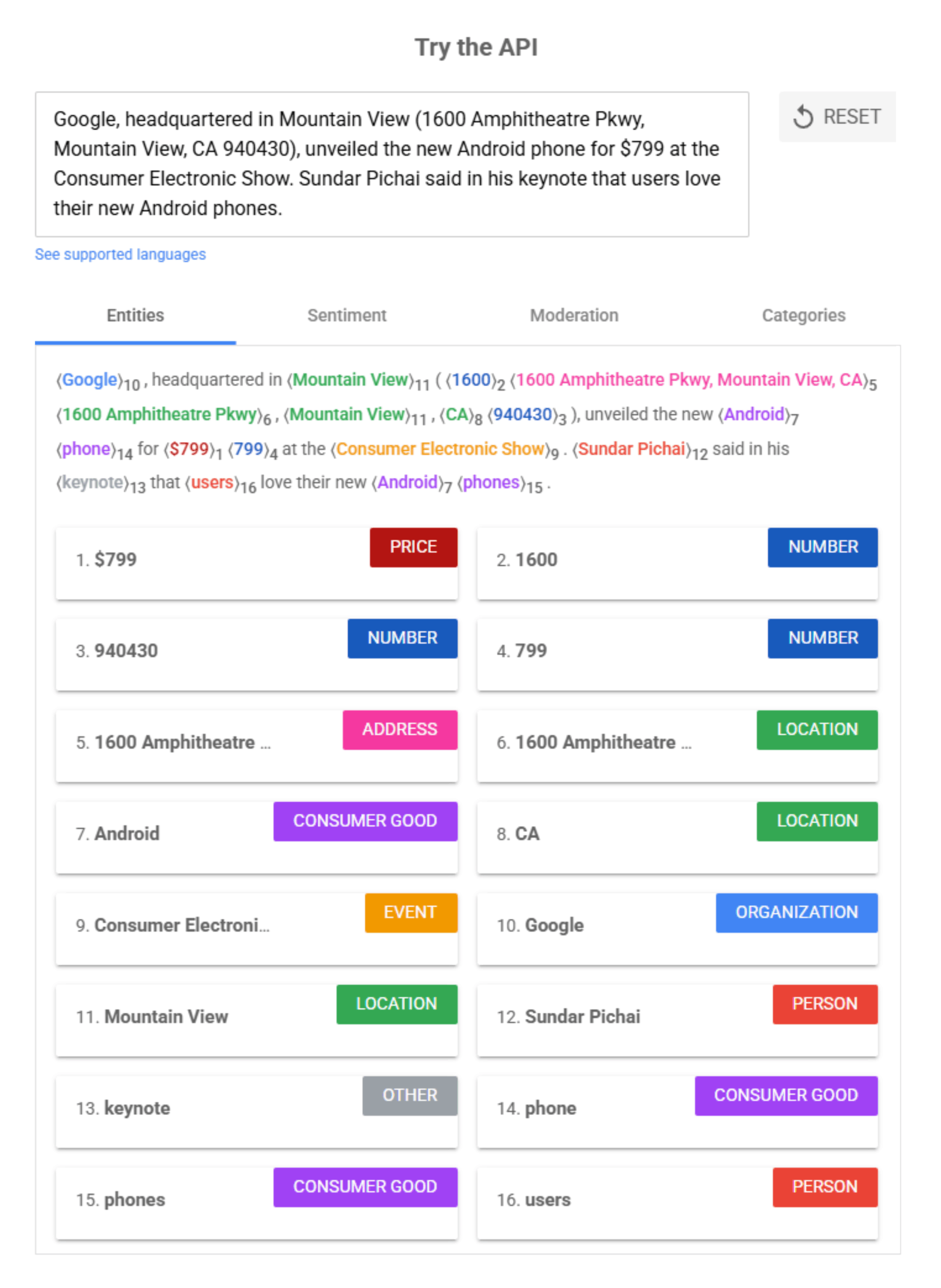
LLMs and Google’s AI Overviews use entities and entity relationships when deciding what to show and where to show it.
Here’s an example to help illustrate this:
When you write about “email marketing,” related entities might include:
- Conversion rates
- A/B testing
- Email automation
- Lead nurturing
- Specific tools (e.g., Mailchimp)
Including these naturally in your content can help search and AI systems understand the full context of what you’re covering.
Tip #7: Choose the Best Format for the Topic
Not every query deserves a blog post. Some searches are clearly better suited to video content.
Like “how to swing a golf club”:
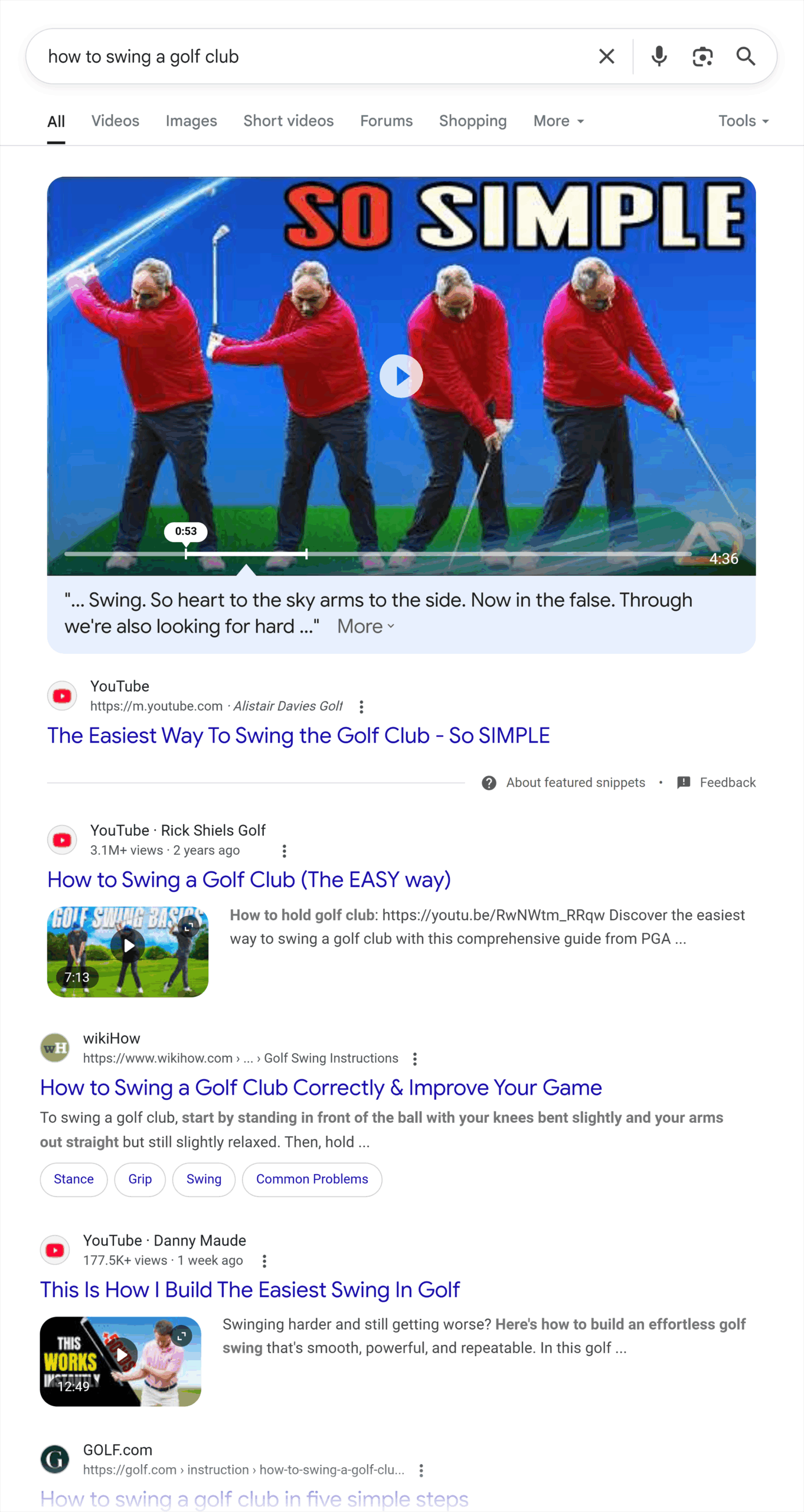
Using the right format can improve your rankings, engagement, and AI visibility.
SEO was never just about written content. But now, thinking about format from the very beginning is almost a requirement.
If you’re just starting out, you need to think about whether your content would be better served by videos, heavily visual content, or even audio for interviews and commentary.
The quickest way to find out?
Run a Google search for your target keywords. If a bunch of videos come up, consider that format. If it’s short-form content, that’s another consideration. If it is just long-form blog articles, then a blog post likely is still a good idea.
Think About Resource Management Upfront
Yes, videos and visual content typically require more resources than blog posts. But consider this scenario:
You spend months creating 20 blog posts that don’t convert well because users actually wanted video tutorials. Now you have to create those videos anyway, and you’ve essentially doubled your work.
Instead, you might spend that same time creating three high-quality YouTube videos that convert much better than those 20 blog posts ever would.
The goal isn’t to intimidate you into expensive video production. It’s to help you think strategically about where to invest your time and energy.
Bonus Tip: Repurpose Your Best Content into Other Formats
Repurposing lets you get more value out of your existing content. Each format serves different user preferences and different platforms.
For example, a detailed article about “email marketing strategy” could become:
- A YouTube video walking through the strategy
- A downloadable checklist
- An infographic for social sharing
- A podcast episode discussing the concepts
Further reading: What Is Repurposing Content?
Tip #8: Publish Content Worth Talking About
Let’s be clear: backlinks are still crucial for ranking higher on Google. This is especially true for competitive keywords.
Just look at the number of links pointing to sites that rank for a term like “project management software”:

But in a world where visibility matters across different search surfaces — not just traditional Google rankings — mentions become extremely powerful.
LLMs and AI tools pull information from across the web, whether there’s a clickable link…

…or not:
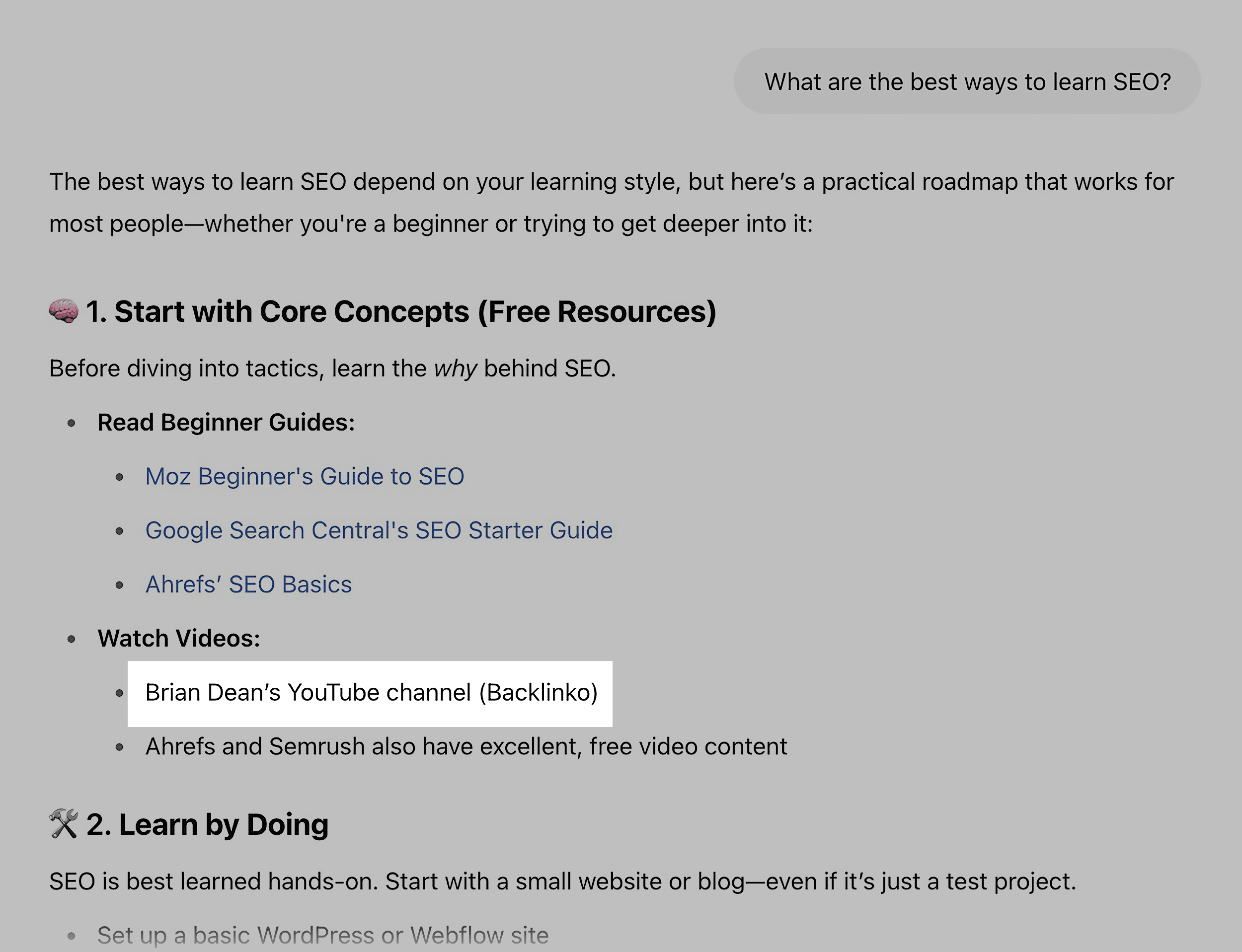
When your brand gets mentioned on forums like Reddit, in newsletters, or in social media discussions, those mentions can feature in AI summaries and overviews.
And with Google’s AI Mode rolling out, “ranking at the top of Google” becomes “being mentioned at the top of Google’s answers.”
That’s why you need content worth citing, even when people don’t link back to you.
The good news is that a lot of what it takes to get more mentions is similar to what it takes to build high-quality backlinks.
Here are a few key ways to get more mentions:
Include Original Research, Insights, or Frameworks
This is the classic “become a source” approach. Create content that others naturally want to reference. We do this all the time with our studies:
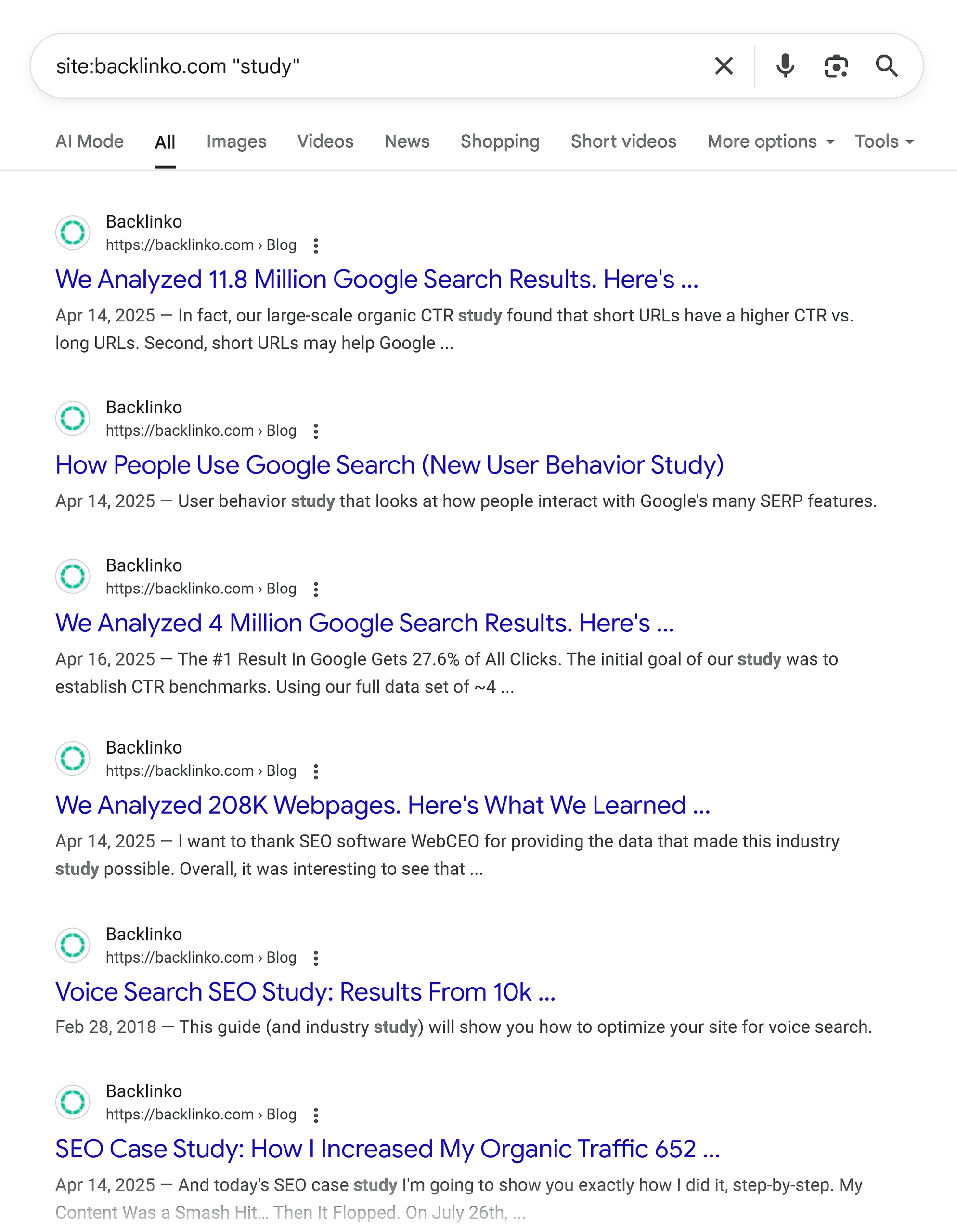
And they get mentioned all over the internet (not always with a link):

This could be full studies with original data. Or it could be frameworks and insights woven throughout your regular content that people find worth quoting.
When you publish something genuinely useful and original, other creators will mention it — with or without a link.
Be Quotable
Use clear, bold statements that people can and will want to reference.
This ties into originality. Don’t just follow the herd, but also don’t be contrarian for the sake of it. People will only quote you if what you’re saying resonates with them and they can’t get the same insight from someone else.
Ask yourself: Am I saying something someone could just find in a Wikipedia article? Or is this actually original enough that people feel they need to mention me as the source?
Pitch Journalists, Podcasters, and Newsletter Writers
Ideally, when you pitch other creators, you’ll get backlinks from these outreach efforts, which directly help you rank higher on Google. But even when you just get mentioned in their content, you’re becoming part of the wider discussion around your topic.
This boosts your brand presence across the platforms where AI tools (like Google’s AI Mode and AI Overviews) pull information.
Track Your Mentions with Monitoring Tools
Tools like Semrush’s Brand Monitoring can help you see where you’re being mentioned across the web.

Semrush also has an AI Visibility Toolkit that lets you see what AI systems think about your brand.

Note: These tools are evolving fast, as is the AI space in general. For more on what this all means, check out our guide to LLM visibility.
Why This Matters for Rankings
Mentions signal authority even when there’s no clickable link. When your brand consistently appears in discussions around your topic, it reinforces your expertise in that area.
This doesn’t replace the need for traditional backlinks. But it does influence where you appear across search surfaces, from AI Overviews to traditional search results.
The goal is building a reputation that extends beyond your own website — becoming the source people naturally reference when discussing your topic.
Why Ranking High on Google Still Matters
Ranking high on Google is still a worthwhile goal. But it’s only useful if it leads to:
- Clicks from the right audience
- Visibility in the right moments
- Progress towards tangible business outcomes
Want to stay ahead of your competition and understand what it takes to rank on Google in the AI era? Check out our guide to generative engine optimization (GEO).
Backlinko is owned by Semrush. We’re still obsessed with bringing you world-class SEO insights, backed by hands-on experience. Unless otherwise noted, this content was written by either an employee or paid contractor of Semrush Inc.


